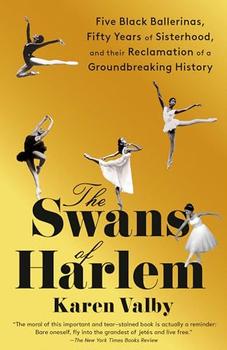Summary | Excerpt | Reviews | Beyond the Book | Read-Alikes | Genres & Themes | Author Bio

Five Black Ballerinas, Fifty Years of Sisterhood, and Their Reclamation of a Groundbreaking History
by Karen ValbyThis article relates to The Swans of Harlem
In The Swans of Harlem, Karen Valby explains how Arthur Mitchell sought to make ballet appealing and relevant to a Black audience. He and his dancers regularly visited schools to give talks and performances. Mitchell loved to point out how ballet could help the students in their daily lives. He'd tell the boys how much higher they could jump during basketball if they learned to jeté. He would demonstrate how you could find ballet anywhere and would break down the latest dance trends to prove it—while making ballet more approachable at the same time.
One popular dance was the "Camel Walk." That was a ragtime dance popular in vaudeville in the 1920s, but it had a resurgence in the '60s and '70s as a retro craze—one that inspired James Brown and Michael Jackson. The '60s version was a sort of hunched shuffle. Try learning it here:
When Mitchell demonstrated the walk, he probably pointed out how you have to remember moves for your hands and feet, keeping tight control over both. Ballet is built around five positions of the feet and five positions of the arms, so the dancers must be good at this kind of coordination.
The "Bus Stop" was a popular disco move that could really benefit from a ballet background.
To do the third step of the dance, you must start with your feet pivoted out in a "duck quack." Ballerinas often recognize one another by their duck feet, always outturned from so much en pointe work. In ballet, it should be easy to tell if a dancer's foot is flat or elevated; they have to decisively plant their feet and shift their weight. Though, frankly, if you're an en pointe ballerina, you've probably advanced beyond learning the "Bus Stop."
The "Pony" is probably the easiest dance Mitchell taught because there are fewer steps to it and dancers can choose what to do with their arms. Popularized by Chubby Checker, it was a beloved social dance. While the steps don't look too daunting, adding the required speed would be a challenge for novice dancers like me. It might look a little silly, but dancers like this guy can make it seem really cool!
Experienced dancers know that the key to keeping your footing is to work with the rhythm, listening for it before trying to mimic its steps.
The "Continental Line Dance" was another 1960s craze popularized by Chubby Checker. It looks pretty easy but crossing your foot over can get tricky when you're focusing on other things. This dancer has it down:
Ballerinas can pull this one off because of their experience with battement, or ballet kicks. The Dance Domain's guide to better battement advises that you keep yourself centered and feel yourself through your whole foot—tips that will probably help you pull off a Continental.
So there you have it. If you find yourself in the 1960s and you want to go dancing, find a ballerina and hit the town.
Filed under Music and the Arts
![]() This "beyond the book article" relates to The Swans of Harlem. It originally ran in May 2024 and has been updated for the
February 2025 paperback edition.
Go to magazine.
This "beyond the book article" relates to The Swans of Harlem. It originally ran in May 2024 and has been updated for the
February 2025 paperback edition.
Go to magazine.
I find that a great part of the information I have was acquired by looking something up and finding something else ...
Click Here to find out who said this, as well as discovering other famous literary quotes!
Your guide toexceptional books
BookBrowse seeks out and recommends the best in contemporary fiction and nonfiction—books that not only engage and entertain but also deepen our understanding of ourselves and the world around us.